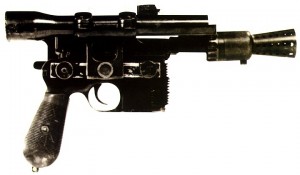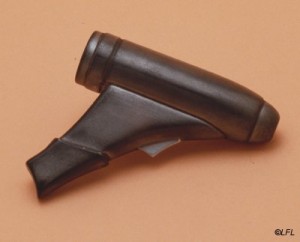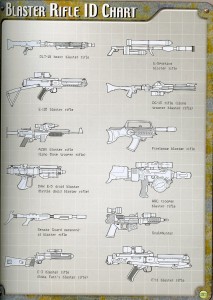TOR Lore: A Good Blaster At Your Side
“Hokey religions and ancient weapons are no match for a good blaster at your side, kid.” While the validity of this statement is questionable (you don’t often see people deflecting lightsaber strikes with blaster bolts), the truth remains that blasters are still pretty awesome. Ranging from the traditional blaster pistol to the massive blaster cannons found on starships, blasters are easily the most common weapon one can find in the Star Wars universe. Held by everyone from the common farmer to smugglers to bounty hunters, blasters of all shapes and sizes are extremely deadly in the right hands. Today we will take a quick look at the history behind these weapons, and learn a little bit about what makes them work.
Many people often assume that a blaster and a laser refer to the same type of weapon, but this is simply not the case. Lasers are an older style of particle beam weapon, and though they are slightly more accurate, they have a much slower recharge rate. Because of this, blasters have a much higher rate of fire than lasers, making them the favored variety of weapon despite their lower accuracy. Blasters generally fall into three different categories; pistols, rifles, and cannons. Blaster pistols are generally considered a sidearm and secondary weapon by military personal, though many individuals outside of the military used them as their primary weapon. Blaster rifles pack more power than their smaller counterparts and have a much longer range, though they are understandably much more difficult to conceal. Blaster cannons are often mounted on vehicles and starships and pack the most power out of all the blaster variants, though starships often use the more powerful and accurate laser cannon as their primary weapons with the faster firing blaster cannons as secondary weapons.
Blasters fire a compressed, focused, high energy particle beam that is commonly referred to as a “bolt.” The composition and characteristics of a blaster bolt will vary depending on the means used to produce it, but all the variants are very destructive. Most personal blasters produce these bolts by relying on two different types of ammunition, a gas cartridge and a power cell. The power of the bolt produced was dependent largely on the amount of gas utilized by the blaster. Smaller, less powerful blasters relied mostly on the power cell for energy, while larger or illegally modified blasters used more gas to produce a powerful and deadly bolt capable of dealing more damage. Many blasters also come equipped with a stun setting that could be used to paralyze and incapacitate targets.
A common misconception about blaster bolts is how they actually damage their targets. Some believe that they deal damage by cutting through the object they hit, much like a lightsaber. This is not the case however. In actuality, blaster bolts cause damage by dissipating a small explosion of heat and force upon their target. This is why we see the small impact point on unshielded targets that are struck by a bolt, though the more powerful versions are more than capable of blowing chunks out of their targets.
The more powerful (and useful) personal blasters often come with several accessories, usually installed by their owners. Some of the more common accessories include targeting lasers, larger power packs, scopes, as well as various types of plating and barrels designed to get the most out of a weapon. Some of the more advanced scopes can even interface with the owner’s helmet, granting them increased accuracy and a variety of battle data. Some types of blaster plating can even help reduce the heat buildup on weapons, allowing for more concentrated and rapid bursts of fire. With the right modifications a blaster pistol can even be made to deal as much damage as a blaster rifle, though such modifications are often highly illegal.
One special type of blaster that I have not mentioned so far is the ion blaster. Like the more traditional blasters, they come in pistol, rifle and cannon form. Unlike traditional blasters, they do little to no damage to organic beings, though the sheer power of a large ion cannon could kill an organic target. Ion weaponry was instead used to disable electronics, droids, and even starships. Ion weaponry rarely dealt any permanent damage to their targets, though they are powerful enough to disable any electronics they strike through the course of a battle. So, while they are a far more specialized form of weaponry than the traditional blaster, ion weapons could be invaluable in the right situations.
So, are blasters more useful in a fight than a lightsaber? Probably not in a one-on-one situation, unless the person with the blaster happens to be incredibly skilled. But if there is one thing the blaster has over the lightsaber it is sheer numbers. The average Force user can only defend themselves against so many blaster bolts before they are overwhelmed, and there are far more blaster users in the universe than lightsaber users. Given that blasters are just as customizable as lightsabers, and require far less training to use without chopping off a limb, there just may be some truth in the “good blaster beats hokey religion” statement.
Comments Off on TOR Lore: A Good Blaster At Your Side







